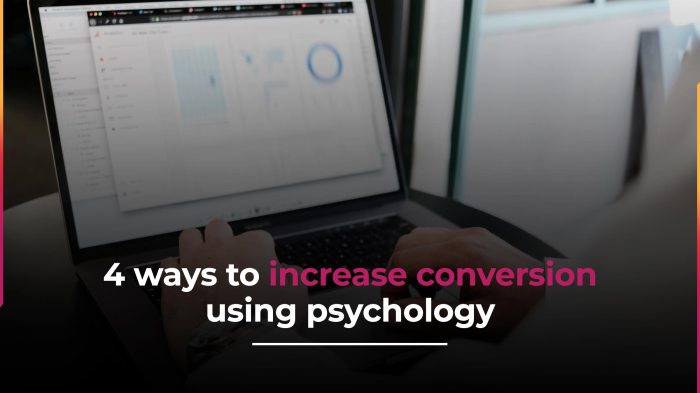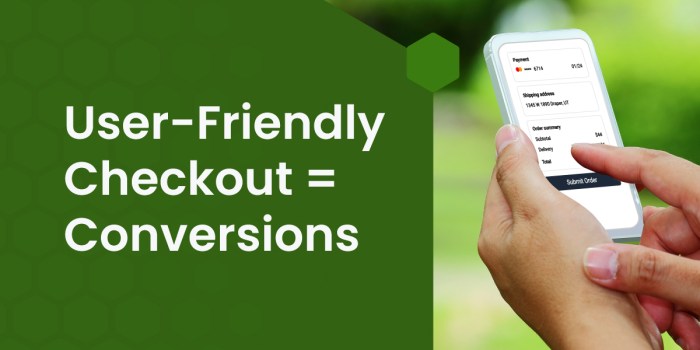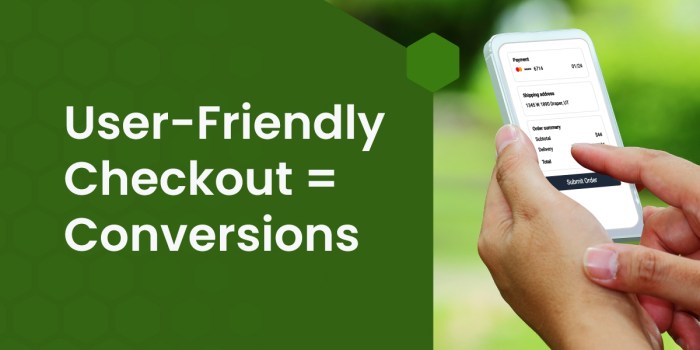5 ways to improve checkout page conversions using psychology explores the psychological factors influencing online purchasing decisions at the checkout stage. Understanding these factors can dramatically increase conversion rates by tapping into customer needs and motivations. From building trust to simplifying the process, we’ll delve into practical strategies that leverage psychology to boost your sales.
This post examines how psychology influences the entire checkout experience, from initial trust-building to handling errors and abandoned carts. By understanding cognitive biases and emotional responses, you can optimize each step to encourage conversions. We’ll use a combination of examples, tables, and flowcharts to visualize the concepts and strategies discussed.
Checkout Page Psychology Overview
The checkout page is the final frontier in the online shopping journey. A seamless and intuitive checkout experience directly impacts conversion rates. This critical stage requires a deep understanding of the psychological factors influencing purchasing decisions, as well as the common cognitive biases and emotional responses that might hinder a sale. Optimizing the checkout process, by carefully considering these factors, is paramount for businesses aiming to maximize online revenue.Understanding the psychology behind consumer behavior at the checkout stage allows businesses to design a process that reduces friction and increases the likelihood of completing a purchase.
This involves acknowledging the various mental shortcuts and emotional triggers that influence decision-making, and then using this knowledge to build a more persuasive and efficient checkout flow.
Factors Influencing Online Purchasing Decisions
Several psychological factors significantly influence online purchasing decisions at the checkout stage. These include the perceived value of the product, the ease and security of the payment process, and the perceived trustworthiness of the website. Consumers are influenced by their own unique experiences, beliefs, and expectations. A positive experience can create brand loyalty and drive repeat purchases.
Cognitive Biases and Emotional Responses
Common cognitive biases and emotional responses that impact conversion rates during checkout include loss aversion, social proof, scarcity, and anchoring. Loss aversion, for instance, suggests that people are more motivated to avoid losses than to achieve gains. This is why offering a limited-time discount or a guarantee of satisfaction can be powerful motivators. Social proof, based on the concept of conformity, encourages consumers to follow the actions of others, such as positive reviews or testimonials.
Want to boost those checkout page conversions? Understanding the psychology behind consumer behavior is key. Five proven methods exist to optimize this crucial stage. But, effective mobile UX testing is equally vital. Tools like those available in testing tools for mobile ux help ensure your checkout page flows seamlessly on all devices.
Ultimately, knowing how users interact with your checkout process, regardless of device, is essential to refine those 5 strategies for improved conversion rates.
Scarcity, on the other hand, leverages the fear of missing out (FOMO) to encourage immediate purchases. Anchoring, a common cognitive bias, suggests that the initial price presented has a significant impact on subsequent perceptions of value. All these factors affect the consumer’s decision-making process during the checkout.
Optimizing the Checkout Process
Understanding these factors enables businesses to optimize the checkout process. This includes making the checkout process as simple and painless as possible. Clear and concise instructions, intuitive navigation, and visible progress indicators all contribute to a positive user experience. By minimizing friction points, businesses can increase the likelihood of a completed purchase. This also involves building trust through clear security measures and transparency in pricing and delivery details.
Effective use of persuasive design elements like trust badges and testimonials further enhances consumer confidence.
Comparison of Psychological Principles, 5 ways to improve checkout page conversions using psychology
| Psychological Principle | Description | Checkout Page Application | Example |
|---|---|---|---|
| Loss Aversion | People are more motivated to avoid losses than to achieve gains. | Highlight the potential loss of a discount or free shipping if the purchase isn’t made immediately. | “Limited-time offer: Get 20% off if you order within the next hour.” |
| Social Proof | People tend to follow the actions of others. | Display customer reviews, testimonials, or social media mentions on the checkout page. | “99% of our customers rate us excellent” |
| Scarcity | People value things more when they are perceived as limited. | Use phrases like “limited-time offer” or “only a few left in stock.” | “Only 10 units left! Order now.” |
| Anchoring | The initial price presented significantly impacts perceptions of value. | Present a higher price initially and then offer a discounted price. | “Originally $100, now only $75” |
Building Trust and Confidence
A crucial aspect of e-commerce success hinges on instilling trust and confidence in customers during the checkout process. Customers are naturally hesitant when handing over their payment information online. Successfully navigating these anxieties is vital for conversions. Establishing trust early and consistently throughout the checkout journey can significantly impact purchase decisions.Building trust is a multi-faceted strategy that requires careful attention to detail.
Ever wonder how to boost those online checkout conversions? Psychology plays a huge role. Five key strategies can significantly improve your results, like understanding customer needs and trust signals. But, let’s be honest, social media can sometimes be a double-edged sword. Social media can destroy a carefully crafted brand image if not managed correctly, leading to lost sales.
Fortunately, understanding these psychological tactics can help overcome these obstacles and bring your customers back to your checkout page for a successful purchase.
It’s not just about displaying security badges; it’s about creating a holistic experience that fosters a sense of security and reliability. This involves transparency, clear communication, and demonstrable commitment to customer well-being. By addressing potential concerns proactively, businesses can empower customers to proceed confidently with their purchases.
Strategies for Building Trust
Establishing trust requires a proactive approach, addressing potential customer anxieties head-on. This begins with displaying clear security measures and fostering a sense of reliability through various signals. Trust signals are more than just logos; they are visual cues that communicate reliability and safety. Their impact on conversion rates is demonstrably positive.
Trust Signals and Their Effectiveness
Trust signals, like security badges, customer testimonials, and social proof, are powerful tools for boosting confidence during the checkout process.
- Security Badges: These badges, often displaying logos of trusted security providers (e.g., SSL certificates), instantly reassure customers that their data is protected. Their effectiveness stems from the immediate visual confirmation of secure transactions. For example, a padlock icon next to the website address, coupled with the HTTPS protocol, is a common trust signal. These visual cues are often very effective at building customer confidence.
- Customer Testimonials and Reviews: Authentic customer feedback is invaluable. Displaying positive reviews and testimonials on the checkout page can significantly influence purchase decisions. Real customer experiences build trust and showcase the value proposition of the product or service. For example, a prominent placement of positive customer reviews on a travel booking platform can encourage users to complete the booking process.
- Social Proof: Leveraging social proof mechanisms, like displaying the number of satisfied customers or highlighting popular items, can encourage purchasing. This works because customers are naturally influenced by the actions of others. For example, a website displaying the number of users who have recently purchased a particular product, or the number of positive reviews, can serve as a powerful signal to the user.
Communicating Security Measures and Policies
Transparency about security measures and policies is crucial. Clearly outlining these policies builds customer confidence and alleviates potential concerns.
- Detailed Security Policies: Providing clear and concise information about the security measures employed, like encryption protocols, can assuage concerns about data breaches. This approach should be concise, but also provide enough details to convey confidence and reassurance. For example, a prominent link to a detailed privacy policy page will build trust.
Displaying Customer Reviews and Ratings
Strategically displaying customer reviews and ratings can significantly impact conversion rates. A high volume of positive feedback and ratings serves as a powerful indicator of product quality and customer satisfaction.
- Strategic Placement: Placing reviews prominently on the checkout page, ideally near the payment section, ensures visibility when customers are most engaged in the purchasing process. For example, a star rating system, coupled with user comments, directly below the payment form, can greatly impact conversion rates.
Utilizing Social Proof Mechanisms
Leveraging social proof can effectively influence customer behavior. Highlighting popular items, customer numbers, and other indicators of demand can subtly encourage purchases.
- Highlighing Popular Items: Emphasizing popular items on the checkout page creates a sense of demand, and suggests the item is well-regarded. For example, if a specific product is highlighted as “bestseller,” this can significantly impact a user’s purchasing decision.
Table of Trust Signals and Their Impact
| Trust Signal | Psychological Impact | Estimated Impact on Conversion Rates (Illustrative Example) |
|---|---|---|
| Security badges (e.g., SSL certificates) | Increased perceived security and safety | Potentially +5-10% |
| Customer testimonials and reviews | Social proof, builds trust in quality | Potentially +3-8% |
| Social proof (e.g., number of satisfied customers) | Encourages purchase based on perceived popularity | Potentially +2-7% |
Simplifying the Checkout Process

A smooth checkout process is crucial for maximizing online sales. Customers are more likely to complete a purchase if the checkout experience is intuitive and easy to navigate. Friction points, such as complex forms or confusing steps, can lead to abandoned carts and lost revenue. By streamlining the checkout process, businesses can significantly increase conversion rates.Simplifying the checkout experience goes beyond just aesthetics; it’s about optimizing the entire process to minimize user effort and maximize ease of use.
Thinking about how to boost those checkout conversions? Understanding psychology is key. Five strategies can dramatically improve your conversion rates, and a well-designed pricing page, like the one on pricing page that converts , plays a crucial role. By optimizing your pricing structure and showcasing value effectively, you can lead customers seamlessly through the checkout process.
Using psychological principles, you can further refine the checkout experience to encourage purchases.
This means reducing the number of clicks required, making forms clearer, and ensuring the flow is consistent across all devices. By focusing on the user’s perspective, businesses can transform a potentially daunting task into a seamless and satisfying experience.
Strategies for a Simplified Checkout
Minimizing friction points in the checkout process is key to converting browsers into buyers. Effective strategies focus on user-friendliness and a streamlined experience.
- Clear and Concise Language: Using simple, straightforward language throughout the checkout process is paramount. Avoid jargon or overly technical terms. Phrases should be easily understandable by the average customer, eliminating any ambiguity. This includes product descriptions, terms and conditions, and any information provided during checkout. For instance, instead of “Order Confirmation Number,” use “Your Order ID.” This small change enhances clarity and reduces confusion.
- Streamlined Form Filling: Long, complex forms are a major cause of checkout abandonment. Optimize forms by collecting only essential information. Use pre-populated fields where possible, such as shipping addresses if the customer has previously provided them. Allow customers to save their payment information for future purchases, reducing the effort required for repeat orders. Consider using auto-fill features to minimize manual entry and ensure accuracy.
By reducing the number of fields, you can significantly decrease the amount of time and effort needed for completing the checkout.
- Device Optimization: The checkout process must be optimized for all devices. Ensure the design adapts seamlessly to desktop, tablet, and mobile screens. Mobile-friendly checkouts are crucial for capturing sales on the go. Mobile checkout forms should be concise, using clear buttons and touch-friendly layouts. Consider responsive design principles for an optimal experience across various screen sizes.
- Reduced Steps: Every extra step in the checkout process increases the risk of abandonment. Identify and eliminate unnecessary steps. For instance, combine multiple shipping options into a single field or pre-select the most common delivery methods. By reducing the number of steps, you significantly reduce friction and increase the likelihood of a successful purchase.
Checkout Flowchart
A well-designed flowchart visually represents the checkout process, highlighting each step and its potential branches. This aids in understanding the overall flow and identifying areas for improvement.
| Step | Action | Decision Point |
|---|---|---|
| 1 | Product Selection and Addition to Cart | Proceed to Checkout? |
| 2 | Shipping Address Entry | Use Saved Address? |
| 3 | Payment Information Input | Use Saved Payment Method? |
| 4 | Review Order Summary | Confirm Order? |
| 5 | Order Confirmation and Receipt |
This flowchart, while simplified, provides a clear illustration of the checkout process. Each step represents a potential point of friction that can be minimized through careful design and optimization.
Incentivizing Purchases: 5 Ways To Improve Checkout Page Conversions Using Psychology
The checkout page is the final frontier in the customer journey. A well-designed checkout experience, combined with strategic incentives, can significantly boost conversion rates. This section explores proven methods for incentivizing purchases at the checkout stage, leveraging psychological principles to motivate customers to complete their transactions.Effective incentives go beyond simple discounts. They tap into deeply ingrained human motivations, from the desire for savings to the satisfaction of belonging to a community.
Understanding these motivations and tailoring incentives to specific customer segments is key to maximizing their impact.
Discounting Strategies
Discounting is a fundamental checkout incentive. Offering a percentage-off discount, a fixed dollar amount reduction, or a combination of both can significantly influence purchase decisions. The psychology behind discounts revolves around the perceived value and scarcity. A discount makes the product seem more valuable for the price, while limited-time offers create a sense of urgency, prompting immediate action.
For example, a flash sale or a limited-quantity discount can generate significant interest.
Free Shipping Incentives
Free shipping is a powerful incentive, often exceeding the effectiveness of discounts. The psychological impact of free shipping is related to the removal of a perceived barrier to purchase. Many consumers view shipping costs as an extra burden, so eliminating this cost significantly reduces the friction in the buying process. Businesses often use free shipping as a threshold to trigger higher order values.
Bundle Deals and Product Bundles
Product bundling involves combining multiple products or services into a single package, often at a discounted price. This technique leverages the principle of perceived value. By offering a collection of related items at a lower price than buying them individually, consumers perceive a better deal. This is especially effective for complementing products. For example, a printer and ink cartridge bundle, or a subscription box service.
Loyalty Programs
Loyalty programs incentivize repeat purchases and foster customer relationships. These programs create a sense of belonging and reward for consistent patronage. They can include tiered rewards, exclusive offers, and personalized recommendations. The psychological impact of loyalty programs is based on reciprocity and social proof. Customers feel valued and appreciated, leading to increased loyalty and repeat business.
Table of Incentive Strategies
| Incentive Type | Psychological Impact | Target Customer Segment |
|---|---|---|
| Discounts | Perceived value, scarcity, urgency | Price-sensitive customers, budget-conscious shoppers |
| Free Shipping | Removal of perceived barrier, perceived value | Customers sensitive to shipping costs, those purchasing larger items |
| Bundles | Perceived value, increased purchase quantity, complementarity | Customers looking for variety, those purchasing related items |
| Loyalty Programs | Reciprocity, social proof, appreciation | Frequent buyers, customers seeking exclusive offers, brand advocates |
Handling Checkout Errors and Abandonment
The checkout process is a crucial stage in the customer journey, and a frustrating experience can lead to lost sales and damaged brand reputation. A smooth checkout process is paramount to maximizing conversions. Errors and abandoned carts are significant obstacles that need careful attention. Effective strategies for handling these issues can dramatically impact your bottom line.Checkout errors and cart abandonment are common issues that significantly impact online sales.
Addressing these problems requires a multifaceted approach, combining technical solutions with a deep understanding of customer psychology. A well-designed checkout process that anticipates and resolves errors effectively, coupled with strategies to recover abandoned carts, can significantly boost conversion rates.
Strategies for Handling Checkout Errors
Effective error handling is crucial to maintaining customer trust and encouraging them to complete the purchase. A poorly designed error message can be incredibly frustrating, leading to abandonment. Clearly communicating the issue and providing a solution is key to retaining customers.
- Clear and Concise Error Messages: Error messages should be concise, focusing on the specific problem. Avoid jargon or technical terms. For instance, instead of “Error code 404,” use “The requested page cannot be found. Please try again.” The message should clearly explain the problem and offer a solution. This builds trust by demonstrating a helpful approach to issues.
- Detailed Error Guidance: If possible, provide detailed guidance on how to resolve the issue. For example, if the error is due to an invalid email address, suggest how to check for typos or format issues. This level of detail helps customers resolve the problem without assistance.
- Multiple Retry Options: Allow users to retry the process after addressing the identified issue. This is critical to reduce the perceived frustration. If a user enters an incorrect password, for instance, provide an option to re-enter or reset the password.
- Preventive Measures: Proactive steps to prevent errors are crucial. Validating input fields (ensuring the correct format for email addresses, phone numbers, etc.) helps prevent errors before they occur. This approach reduces frustration by anticipating and resolving potential problems.
Techniques for Recovering Abandoned Carts
Cart abandonment is a significant challenge for online retailers. Understanding the reasons behind it is crucial to developing effective recovery strategies. A well-designed recovery system can significantly reduce losses and retain customers.
- Automated Email Reminders: Set up automated emails to remind customers about items in their abandoned carts. These emails should be timely and personalized, including a clear call to action. For instance, include a link to their cart and a special discount code.
- Personalized Incentives: Offer exclusive discounts or promotions to encourage customers to return to their abandoned carts. These incentives should be tailored to the specific items left in the cart and the customer’s browsing history. Consider a limited-time offer or a discount for completing the purchase.
- Targeted Messaging: Customize email content to address the specific reasons behind abandonment. If customers often abandon carts due to high shipping costs, offer free shipping promotions or alternative shipping options. This approach recognizes the customer’s concerns and offers solutions.
- Clear and Concise Cart Page Design: Ensure the cart page is easy to navigate and provides a quick overview of the items and the total cost. Clear visuals and a streamlined design can encourage customers to proceed with the checkout.
Reducing Checkout Errors
Implementing measures to minimize checkout errors can improve the overall customer experience and boost conversions. Thorough testing and continuous monitoring of the checkout process are critical.
- Thorough Testing: Rigorous testing of the checkout process with various browsers and devices ensures a consistent experience for all users. This step identifies potential errors before they affect customers. For example, test the checkout flow on different browsers like Chrome, Firefox, and Safari.
- Monitoring and Analysis: Tracking error rates and user behavior during the checkout process provides valuable insights into areas for improvement. Analyzing data on error types and frequency allows for targeted interventions to fix issues.
- User Feedback Mechanisms: Collecting user feedback through surveys or feedback forms allows for identification of pain points and areas where the checkout process could be improved. For example, asking customers about their experiences with the checkout flow can identify specific problem areas.
A/B Testing and Optimization

A/B testing is a crucial element in optimizing checkout pages for higher conversion rates. It allows businesses to systematically experiment with different variations of their checkout process, comparing their performance against a control group to identify what works best. This iterative approach, grounded in data-driven insights, is essential for continuous improvement and maximizing the effectiveness of checkout page designs.
Data-Driven Optimization Strategies
Understanding user behavior and preferences is paramount to creating a seamless checkout experience. A/B testing provides the necessary data to identify design elements and features that resonate with customers, leading to higher conversion rates. Careful analysis of the data collected from these tests enables informed decisions, preventing guesswork and ensuring a more effective approach to checkout optimization.
Key Metrics for Analysis
Tracking relevant metrics is vital for understanding the impact of A/B tests. Conversion rate, the percentage of visitors who complete a purchase, is a primary indicator. Average order value (AOV) provides insights into the average amount spent per transaction. Bounce rate, the percentage of visitors who leave the page without interacting further, can also be used to gauge the effectiveness of different checkout variations.
Analyzing these metrics, in conjunction with other relevant data, allows for a comprehensive evaluation of the effectiveness of changes made to the checkout process.
Interpreting A/B Test Results
Interpreting A/B test results requires careful consideration of statistical significance. A statistically significant difference indicates that the observed results are not due to random chance. Results should be interpreted within the context of the specific test hypotheses and goals. For instance, a subtle improvement in conversion rate might not be statistically significant, but a larger change could suggest a successful optimization strategy.
Methods for Conducting A/B Testing
A/B testing tools, readily available in many marketing platforms, automate the process of creating variations, tracking results, and analyzing the data. These tools often offer robust statistical analysis capabilities, assisting in determining the statistical significance of observed differences between variations. The process involves selecting a control group and an experimental group, with different variations presented to each group.
Examples of A/B Test Scenarios
Various A/B test scenarios can be designed to test different psychological principles. For example, testing different call-to-action buttons (e.g., “Buy Now” vs. “Add to Cart”) can reveal which phrasing is more effective. Similarly, testing different levels of product information presented during the checkout process can influence purchasing decisions. Furthermore, adjusting the visual design elements like colors, fonts, and layouts can also affect the overall perception of the checkout page.
The specific tests will depend on the particular psychological principles being investigated.
Outcome Summary
In conclusion, optimizing your checkout page for conversions goes beyond simply making it visually appealing. It requires a deep understanding of the psychological principles driving customer behavior. By focusing on trust, simplifying the process, incentivizing purchases, handling errors effectively, and utilizing A/B testing, you can significantly increase your sales. Remember, a well-designed checkout page is a crucial element in achieving online success.








